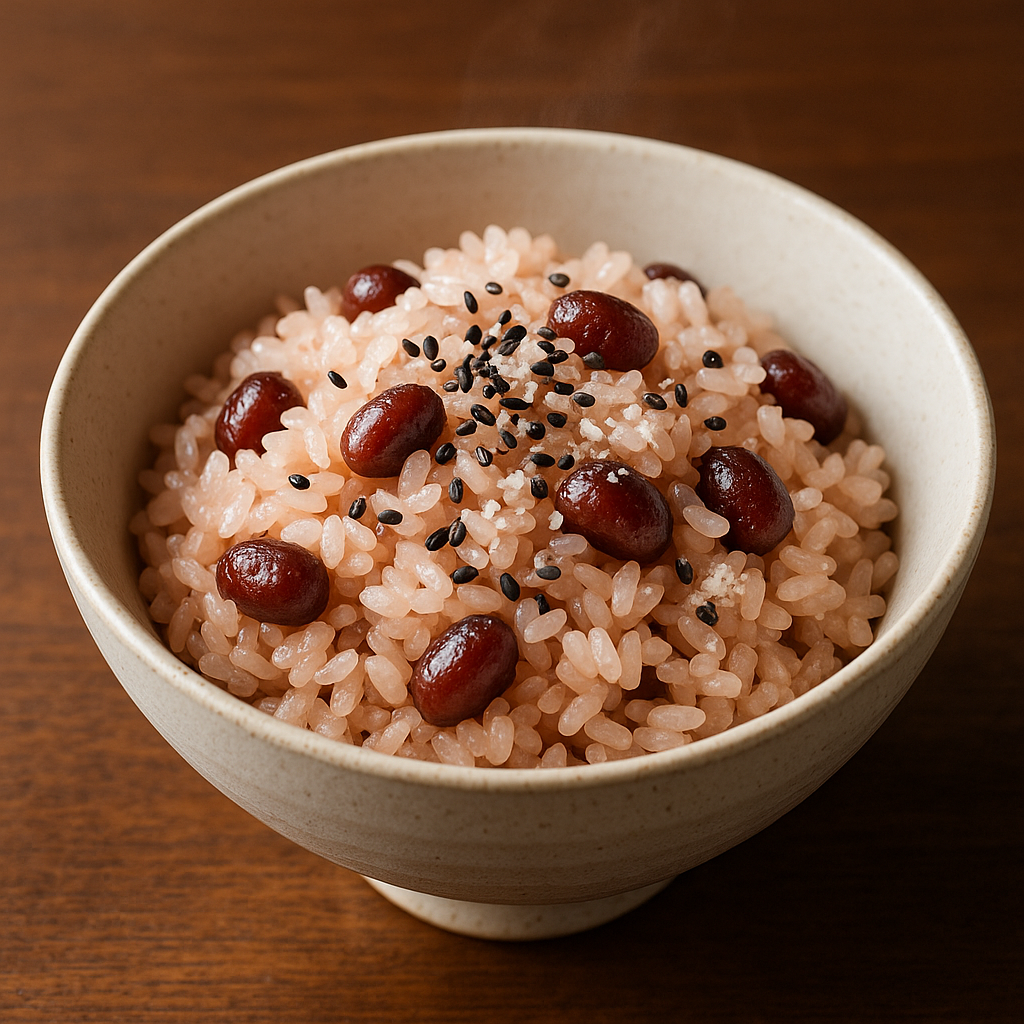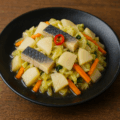赤飯(北海道風)の特徴
小豆ではなく甘納豆を使用
北海道風の赤飯は、一般的に用いられる小豆の代わりに甘納豆を使うのが特徴です。ほんのりとした甘さが加わり、道民にとっては定番の祝い飯です。
もち米を使ったもっちり食感
もち米を蒸して炊き上げるため、もっちりとした食感が楽しめます。甘納豆のほのかな甘みと塩気の効いたごま塩が絶妙にマッチします。
祝い事に欠かせない料理
誕生日や入学式、結婚式など、祝い事の場で必ずといっていいほど登場する料理で、家庭や地域の行事で広く親しまれています。
赤飯(北海道風)のレシピ
材料(4人分)
- もち米 … 2合
- 甘納豆(赤えんどう豆や金時豆など) … 150g
- 水 … 適量
- ごま塩 … 適量(仕上げ用)
作り方
- もち米を研ぎ、2〜3時間ほど浸水させてから水を切る。
- 蒸し器にさらし布を敷き、もち米を蒸す。
- 蒸し上がったら甘納豆を混ぜ、器に盛る。
- 仕上げにごま塩をふりかけて完成。
シェフのワンポイントアドバイス
甘納豆は蒸し上がったもち米に後から混ぜるのがポイントです。
先に入れると溶けてしまい、豆の形が崩れやすくなります。
赤飯(北海道風)の栄養価(1人分の目安)
- エネルギー:約300〜350 kcal
- たんぱく質:6〜8 g
- 脂質:1〜2 g
- 炭水化物:70〜80 g(主にもち米由来)
- 食物繊維(豆由来)
- 鉄分・マグネシウム(豆由来)
もち米のエネルギーに加え、豆の食物繊維やミネラルも摂れる、祝い事にふさわしい栄養バランスの良い料理です。
赤飯(北海道風)の歴史
甘納豆赤飯の誕生
戦後の北海道で、小豆が手に入りにくい時代に甘納豆を代用したのが始まりとされています。
家庭料理としての定着
甘納豆の優しい甘みが好まれ、家庭料理として広がり、祝いの席の定番となりました。
北海道独自の食文化
現在では北海道の「常識」として知られ、本州の赤飯とは異なる独自の食文化を築いています。
English Version
Features of Hokkaido-Style Sekihan (Red Rice)
Made with Sweetened Red Beans Instead of Azuki
Unlike the traditional Japanese sekihan, the Hokkaido version uses sweetened beans (such as candied red peas or kidney beans) instead of azuki beans. This subtle sweetness is a signature flavor loved by Hokkaido locals.
Chewy Texture from Mochi Rice
The dish is made by steaming glutinous rice, resulting in a pleasantly chewy texture. The sweet beans blend beautifully with the slight saltiness of sesame salt sprinkled on top.
A Must for Celebrations
This dish is commonly served at celebrations such as birthdays, school admissions, and weddings, making it a staple for festive occasions in Hokkaido.
Recipe
Ingredients (for 4 servings)
- Glutinous rice … 2 cups
- Sweetened beans (red peas or kidney beans) … 150 g
- Water … as needed
- Sesame salt … to taste (for garnish)
Instructions
- Rinse the glutinous rice and soak it in water for 2–3 hours. Drain well.
- Steam the rice in a steamer lined with cloth until cooked.
- Mix in the sweetened beans after steaming, then transfer to serving bowls.
- Sprinkle with sesame salt before serving.
Chef’s Tip
Add the sweetened beans after the rice has been steamed. If added too early, the beans may break down and lose their shape. This way, the dish maintains both texture and appearance.
Nutritional Value (per serving, approx.)
- Calories: 300–350 kcal
- Protein: 6–8 g
- Fat: 1–2 g
- Carbohydrates: 70–80 g (mainly from glutinous rice)
- Dietary fiber (from beans)
- Iron and magnesium (from beans)
This festive dish provides energy from glutinous rice along with fiber and minerals from the beans, making it both hearty and nutritious.
Historical Background
Origin of Sweet Bean Sekihan
It is said to have originated in post-war Hokkaido, when azuki beans were scarce and sweetened beans were used as a substitute.
Established as a Home-Cooked Tradition
The gentle sweetness of the beans made the dish popular in households, eventually becoming a standard dish for celebratory occasions.
A Unique Hokkaido Food Culture
Today, this sweet style of sekihan is considered common sense in Hokkaido, standing apart from the azuki bean sekihan commonly served in the rest of Japan.



何でも質問してください!